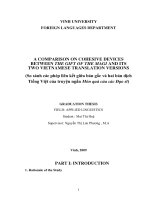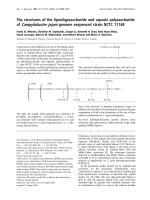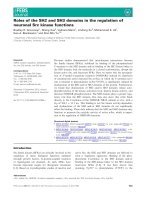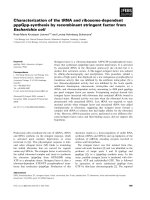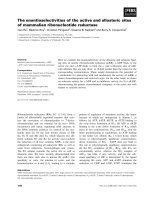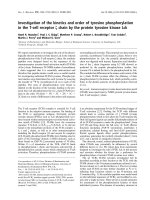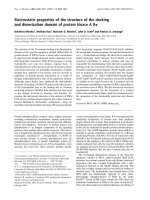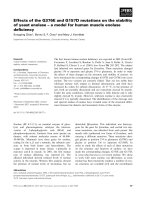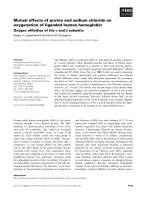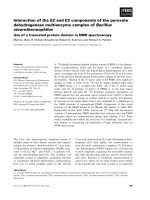Separation of the tax and audit function Motivation and consequences
Bạn đang xem bản rút gọn của tài liệu. Xem và tải ngay bản đầy đủ của tài liệu tại đây (678.26 KB, 97 trang )
SEPARATION OF THE TAX AND AUDIT FUNCTION: MOTIVATION
AND CONSEQUENCES
by
Bradrick M. Cripe
A DISSERTATION
Presented to the Faculty of
The Graduate College at the University of Nebraska
In Partial Fulfillment of Requirements
For the Degree of Doctor of Philosophy
Major: Interdepartmental Area of Business (Accountancy)
Under the Supervision of Professor Paul A. Shoemaker
Lincoln, Nebraska
August, 2006
UMI Number: 3214106
3214106
2006
UMI Microform
Copyright
All rights reserved. This microform edition is protected against
unauthorized copying under Title 17, United States Code.
ProQuest Information and Learning Company
300 North Zeeb Road
P.O. Box 1346
Ann Arbor, MI 48106-1346
by ProQuest Information and Learning Company.
SEPARATION OF THE TAX AND AUDIT FUNCTION: MOTIVATION
AND CONSEQUENCES
Bradrick M. Cripe, Ph.D.
University of Nebraska, 2006
Advisor: Paul A. Shoemaker
This study examines companies choosing to separate the tax and audit
function prior to and subsequent to the passage of the Sarbanes-Oxley Act (“the
Act”). While the provision of tax services is not currently prohibited by the Act,
some companies have separated these two functions. An examination of the
relationship between tax function separation and audit quality, financial
statement visibility and tax minimization proxies is performed for two different
samples: (1) a matched pair design for companies engaging their audit firm for
tax work in 2001 (2 years before the Sarbanes-Oxley Act was placed in effect)
and then separating the tax and audit function by 2003 (the effective year of the
Sarbanes-Oxley Act), and (2) a logistic regression analysis on all companies in
the Russell 2000, a major market index, for 2002-2004. The data used in this
study is compiled from proxy statements filed with the Securities and Exchange
Commission and commercially available information from I/B/E/S,
COMPUSTAT and AuditAnalytics.
After controls for size, industry and growth are added to the model, the results
reveal that in some years separation companies pay significantly less for their
audit and, as a consequence, have higher instances of financial statement
restatement. These results support the idea that the integration of audit and tax
provide a better quality audit, supporting prior empirical work of Kinney et al.
(2004) and anecdotal evidence from accounting firms. Some evidence for 2004
exists that separation companies are actually becoming less visible in the capital
markets. Given that audit quality, analyst following, share turnover and
management ownership are decreasing, this implies that these companies are
less concerned with financial reporting quality. Overall, these findings suggest
that tax service separation may be motivated by factors beyond merely shopping
for the best tax provider.
ACKNOWLEDGEMENTS
I dedicate this dissertation to my wife, Rochelle, who has brought so much
happiness and joy to my life. Thank you for your love, unwavering support,
encouragement and your abundant laughter, which has carried me through so
much of this process. I am blessed to have met you, and you have made me the
luckiest man in the world. I will always be happy surrounded by the love that
we have for each other. You are such an important part of this work, from the
nights we sat together inputting data to the times you lifted me up and asked me
to carry on. Your name will always be associated with this project and with all
the wonderful things we will accomplish together. I pledge to you my love and
my heart forever.
I would not have been the person I am today without the support of my parents,
Michael and Jacqueline Cripe. Thank you for always believing that I could
accomplish great things, even when I did not believe in myself. Your constant
support, encouragement and your commitment to me all these years is directly
responsible for the completion of this work. I have always known only abundant
love from the two of you, and I can never express to you how much I appreciate
all that you have done. My greatest contribution to this world will be to continue
in your tradition of being an outstanding parent and a loving partner.
I would also like to thank the faculty of the University Of Nebraska School Of
Accountancy for all of your help to prepare me for a successful scholarly career.
I wish to acknowledge the significant contribution of my dissertation
committee: Dr. Paul A. Shoemaker (chair), Dr. Renée A. Price, Dr. Rafael
DeAyala, and Dr. John E. Anderson. Thank you for reading all the drafts,
catching the mistakes, suggesting alternative measures and models, and for
being patient with me. Their efforts contributed significantly to the quality of
this paper, and any remaining errors or omissions are my responsibility alone. I
am particularly thankful to Paul Shoemaker for being a terrific chair and a great
mentor. Any errors I made, whether in the classroom or on this project, were
always corrected gently and with great care. Thank you for always being there
when I needed to knock on the door and thank you for all of your counsel.
I am also very grateful to those individuals who shared their time with me in the
doctoral program here at Nebraska. I am honored to have shared this experience
with my program counterparts: Jennifer Blaskovich, Brian McAllister, Piyaratt
Jantadej, Myungsoo Son and Yijiang Zhao. Thank you all for your
encouragement all these years! I am very grateful to Jennifer, Brian and Piyaratt
for always listening and for all the advice and encouragement you provided
throughout this long journey. There were times when the path was uncertain,
and I always knew they would provide the answer that was true and in my best
interest, even when it wasn’t what I wanted to hear! I also want to thank those
who came after me in the program and whose wisdom and advice are important
to me: Brenda Rees, Jurgen Sidgman, Roopa Chandrasekhar, Amy Fredin, and
Matt Gleason. I thank you all for helping me throughout this process!
I am also thankful to Dr. Arthur Allen and Dr. Linda Ruchala for providing the
foundation in capital market and behavioral/managerial research that I will use
in my career. I want to thank Carol Danielson and Susan Simpson for answering
all of my questions, keeping me out of trouble, and for giving me cookies and
cake all these years! You made my life so much easier!
My friends and family contributed so much to the person I am today. First, I
want to thank Brian McAllister for being such a great companion and
officemate all these years. Brian, you are the wisest person I have ever had the
privilege to work with, and also the most humble. Thank you for allowing me to
be a part of your family, for giving me the opportunity to be Claire’s godfather,
for standing with me on my wedding day, and for making me LAUGH! I will
always remember our first AAA meeting…well, most of it! You and Kristin are
wonderful people and I wish you the very best. I also want to thank Jennifer
Blaskovich and Piyaratt Jantadej for helping me so much throughout this
process. You both have done so much for me that I owe you a debt that will
never be truly repaid. Jennifer, thanks for the recruiting updates for Nebraska
football, for telling me the definition of multivariate analysis, and for sitting
with me through all those statistics classes that sounded like Baptist revivals!
OH YEAH! Jean, thank you for always listening to me, for helping me get
through our comprehensive exams, and for getting Brian and I to the Penn State
football game all those years ago. I hope I didn’t embarrass you!
Next, I want to thank my extended family for all their support during my life.
Dennis and Joyce Free, you have been like a second set of parents and I have
felt less like your nephew and more like your son for all the time and love you
have shown me. Thanks for all the meals and haircuts!
Finally, I would like to thank Eric Free for being there for me when I needed it
the most. You are such an amazing person: someone who is smart, incredibly
successful, always positive and a true friend. I cannot count the number of times
you and Tanya have invited me into your home and treated me so well. I will
never be able to thank you for showing me what it must be like to have a
brother. I pledge to always be there for you, through the best and the worst, a
friend and brother to you forever!
TABLE OF CONTENTS
Page
LIST OF TABLES iii
SECTION
1 INTRODUCTION 1
1.1 Contribution of the Study 2
1.2 Research Methodology 2
1.3 Results of the Study 4
1.4 Organization of the Study 4
2 CURRENT ENVIRONMENT 5
2.1 Independence Under the Sarbanes-Oxley Act 5
2.2 Tax Services Marketing by Public Accounting Firms 7
3 HYPOTHESIS DEVELOPMENT 9
3.1 The Tax and Audit Separation Decision 9
3.2 Non-Audit Services, Auditor Independence and Audit Quality 10
3.3 Agency Costs 16
3.4 Financial Reporting Visibility 18
4 TAX MINIMIZATION AS AN ALTERNATIVE EXPLANATION 20
5 METHODOLOGY AND HYPOTHESIS TESTING 23
5.1 Variable Definitions 23
5.2 Matched Sample Design 27
5.3 Multivariate Prediction Model 28
6 PAIRED SAMPLE DESIGN RESULTS 29
6.1 Sample Selection Procedure 29
6.2 T-Test Assumptions 31
6.3 Descriptive Statistics 33
6.4 Univariate Analysis Results 33
6.5 Multivariate Analysis Results 35
6.6 Sensitivity Analysis 36
7.0 LOGISTIC REGRESSION DESIGN RESULTS 38
7.1 Sample Selection Procedure 38
7.2 Descriptive Statistics 38
7.3 Multivariate Analysis 41
7.3.1 Regression Diagnostics and Influential Observations 41
7.3.2 Model Robustness 42
7.3.3 Results 43
7.3.4 Sensitivity Analysis 44
8.0 SUMMARY AND IMPLICATIONS 45
9.0 LIMITATIONS 47
10.0 EXTENSIONS AND FURTHER RESEARCH 49
REFERENCES 50
TABLES 55
APPENDIX A—TAX SERVICE MARKETING 86
LIST OF TABLES
Table Page
1 Summary of Results 55
2 Variable Definitions 58
3 Sample Description 60
4 Paired Sample Descriptive Statistics 62
5 Logistic Regression Analysis—Matched Pair Design 66
6 Paired Sample Descriptive Statistics and Results 68
7 Logistic Regression Sample Description by Year 72
8 Logistic Regression Descriptive Statistics 73
9 Collinearity Diagnostics 82
10 Logistic Regression Analysis 83
iii
1.0 Introduction
While not required under any current standard, companies are choosing to hire a
different accounting firm to perform the tax compliance and research function
instead of using the accounting firm engaged to perform the audit function. The
integration of the tax and audit function has been credited with providing a
higher quality audit product, due to the synergy that is created when the audit
company provides tax services. Auditors have been credited with examining not
only the accounting implications of proposed transactions, but the implications
for tax and internal controls and increasing due diligence (PCAOB 2004b).
However, recent anecdotal evidence suggests that as many as 25-31% of
companies separate these two functions (PCAOB 2004b). Concerns related to
auditor provision of non-audit services and the perception of a lack of
independence on the part of the auditor, especially for companies visible in the
capital markets or those with high agency costs, may force companies to
separate these two functions as a signal of auditor independence.
Because the Sarbanes-Oxley Act increased audit firms’ litigation risk, auditors
may be less willing to provide tax minimization strategies. The Public Company
Accounting Oversight Board (PCAOB) has proposed new ethics rules that
would ban auditors from providing opinions or providing tax advice deemed
aggressive (PCAOB 2004a). Companies seeking tax minimization strategies not
offered by their audit firm may be forced to seek tax aggressive accounting
1
firms to perform tax services their auditor may be able, but unwilling, to
provide.
1.1 Contribution of the Study
This paper examines the economically feasible reasons for separation of the tax
and audit function. The primary research question focuses on the motivations
and consequences of separation of the tax and audit functions. This study
extends prior research on non-audit fees and auditor independence,
1
using a
specific subset of non-audit fees: fees paid to audit firms for tax work. This
study is one of the first studies to examine the motivation for tax function
separation using tax minimization and capital market visibility as explanations
for separation. This study also provides regulators with additional evidence that
mass separation of the audit and tax function may not prove to be a reasonable
means of improving financial reporting credibility and quality.
1.2 Research Methodology
Using data from 2001-2004, all companies in the Russell 2000 Index are
chosen. The Russell 2000 Index is an index of smaller companies, whose
1
A review of the literature pertaining to the provision of non-audit services and audit quality is
given in Section 3.
2
average market capitalization is 1.03 billion dollars.
2
This is in contrast to the
S&P 500, whose average market capitalization on April 14, 2006 was 23.3
billion dollars.
3
This index is chosen because it comprises smaller companies,
and anecdotal evidence
4
provides support for the argument that smaller
companies are more likely to engage in separation. Two samples are examined.
In the first analysis, a set of companies choosing to separate the tax function
after the passage of the Sarbanes Oxley Act
5
(“The Act”) is matched with
companies engaging their accounting firm for tax and audit services before and
after the Act to determine the differences that contribute to separation.
There are companies within the Russell 2000 index that have always separated
the two functions, have separated the functions and then re-engaged their
accounting firm for tax work, or have never separated the two functions. The
second part of the analysis examines these companies and provides a
multivariate prediction model to examine, by year, variables that may predict
inclusion into the separation group.
2
www.russell.com
3
/>&l=EN&b=4&s=6&ig=48&i=56&si=138&xcd=500)
4
Testimony before the Public Company Accounting Oversight Board (PCAOB) at the Tax
Services Roundtable (7/14/2004) provides anecdotal evidence that smaller companies engage in
separation at a greater rate (almost 31%) than larger companies.
5
The Sarbanes-Oxley Act was signed into law July 30, 2002. The final rule (Rule 202) for the
pre-approval of non-audit services that was included in the Sarbanes-Oxley Act of 2002 was
issued by the SEC on January 26, 2003 and became effective May 6, 2003.
3
1.3 Results of the Study
Univariate and multivariate tests indicate that separation companies pay
significantly less for their audit overall and have higher instances of
restatements in some years, which gives credibility to the claim that separation
companies seek audits that are cheaper but as a consequence have lower quality.
Contrary to expectations, agency costs and capital market visibility concerns do
not seem to motivate separation, since separation firms have significantly lower
amounts of management ownership, analyst following and share turnover in
some years. There is some evidence that tax minimizing behavior is present in
the sample, but significance is found only in the univariate results. Overall, the
results seem to indicate two events occurred over the period within the
separation sample: (1) in 2002 and 2003, separation companies’ audit fees
decreased and audit quality decreased; and, (2) in 2004 management lowered its
ownership stake and analyst coverage and share turnover decreased. Relative to
non separation companies and measured by analyst following and share
turnover, capital market visibility decreased significantly for separation firms
over the period.
1.4 Organization of the Study
This research is organized as follows. The current section provides an
introduction. Section 2 illustrates the current environment facing both public
4
accounting firms and audited companies. Section 3 discusses auditor
independence and capital market visibility as motivations, and audit quality as a
motivation and a consequence of the separation of the tax and audit function.
Section 4 presents tax minimization as an explanation for tax function
separation. Section 5 describes how the hypotheses will be tested and illustrates
the models. Section 6 gives the results of the matched pair design, and Section 7
gives the results of the logistic regression model. Section 8 provides a summary
analysis of the study, and implications of the results. Section 9 discusses the
limitations of the study, and Section 10 provides areas for further research.
2.0 Current Environment
2.1 Independence under the Sarbanes-Oxley Act
One of the purposes of the Sarbanes-Oxley Act was to restore public confidence
in financial statements. The audit committee, as a subset of the board of
directors, was significantly changed as a result of the Act. Each member of the
audit committee is required to be independent, which requires each member to:
(1) remain unaffiliated with the company, (2) refrain from accepting any fees
from the company other than those for services directly related to the audit
committee function; (3) refrain from a relationship with the company that would
interfere with professional judgment; and (4) have ceased prior employment
5
with the company at least three years before serving on the audit committee
6
. In
addition to independence, each committee is required to have at least one
member who is qualified as an “audit committee financial expert”, or show
cause as to why such a member is not present.
7
The Act defines such an expert
as an individual who has an understanding of economic and accounting
principles, as well as an understanding of internal control audit procedures, and
who can comprehend how financial reporting choices and policies affect a
company’s financial reports (Buchalter and Yokomoto 2003). Companies listed
on the NYSE are also subject to stricter exchange rules, which currently require
annual self-assessment by the audit committee (Rossiter 2004).
There is currently no prohibition against an audit firm performing tax services
for their client, as long as the services are pre-approved by the audit committee
and they do not fall within the categories of expressly prohibited services under
the Act. Expressly prohibited services are defined as bookkeeping or services
related to the accounting records of the client, financial information system
design and implementation, appraisal, actuarial services, internal audit
outsourcing, management or human resource functions, broker or dealer
services, legal and expert services unrelated to the audit, or other services the
PCAOB deems unacceptable by standard (SEC Release 33-8183). Recent
6
Item 401(i) of Regulation S-K [17 C.F.R. §229.401(i)] and Item 7 of Schedule 14A [17 C.F.R.
§240.14a-101]
7
Section 407, 15 USC §7265, Rule 2-07 of Regulation S-X [17 C.F.R. §210.2-07]
6
actions by the Internal Revenue Service and the Department of Justice have
raised questions as to whether the marketing of aggressive tax minimization
strategies, or tax shelters, to the company or senior executives by the audit firm
leads to conflicts of interest that could impair independence.
8
The PCAOB has proposed new ethics rules that would indicate independence is
impaired if the audit firm provided tax services that: (1) were on a contingent
fee basis; (2) planned or provided an opinion on the tax consequences of a
transaction that is listed or confidential under Treasury regulations; (3) planned
or provided an opinion on a tax strategy that is based on an aggressive
interpretation of tax laws and regulations, and (4) provided tax services to
officers of the company who serve in a financial reporting oversight role of the
audit client (PCAOB, 2004a). The PCAOB makes it clear that routine tax return
preparation and compliance work is not prohibited under the Act (PCAOB
2004a).
2.2 Tax Service Marketing by Accounting Firms
Accounting firms are marketing tax savings as an important tool for achieving
superior corporate performance. As an example, this is the tax overview on
8
Both Ernst and Young and KPMG have been accused of selling illegal tax shelters to clients
from 1998 to 2000 (Browning 2004, Johnston 2004). KPMG has settled with the Internal
Revenue Service by paying $456 million in fines to defer prosecution of the firm (IR 2005-83).
7
KPMG’s “Comprehensive Capabilities” website,
9
the first page describing their
tax practice:
“Our Tax Services practice is also about finding opportunities - rich
opportunities for tax savings that can make a significant difference on client
balance sheets. Eliminating unnecessary [tax] expense by helping companies
achieve an optimum tax structure - through tailored, high-quality services - is
what the practice is known for. “
For example, a sale-leaseback transaction is one type of strategy that has
significant balance sheet and tax implications. In a sale-leaseback transaction, a
company sells an asset at fair value to a third party and immediately leases the
asset back as an operating lease. This has the advantage of providing increased
short-term liquidity to the company, removes underperforming assets from the
balance sheet, and can provide federal, state and local tax savings if the
company has a net operating loss or other tax carryforward. Given bold claims
of how tax work can be implemented into a business strategy, and how tax
strategies can make differences on client balance sheets, one can reasonably
conclude that tax services can make a difference in how financial statements are
presented.
The SEC has taken the position that legal and expert services, even if unrelated
to the audit, impair independence (SEC release 33-8183). When public
9
8
accounting firms advertise how their expertise in tax related matters can be used
to make a difference on financial statement presentation and preparation,
independence in appearance can be questioned because the advertising claims
the firm will act as an advocate for a particular decision or goal. If the
advertisements of the accounting firms are true, then tax compliance and
research is a consulting function that could significantly affect the accounting
for complex transactions. Auditor independence is critical to investor
confidence, and stakeholders become concerned when they detect any action
that may impair, or appear to impair, auditor independence (Panel on Audit
Effectiveness 2000).
3.0 Hypothesis Development
3.1 The Tax and Audit Separation Decision
The purpose of this study is to examine the economically feasible reasons for
separation of the tax and audit function. There are several reasons why
companies would voluntarily choose to separate these two functions: (1) as a
signal of increased audit independence by reducing the amount of non-audit fees
paid to the accounting firm and limiting the potential economic dependence of
the auditor on the company; (2) as a cost avoidance mechanism by simply
choosing to perform the tax work with the staff currently employed by the
company; (3) as a tool for tax minimization, whereby the company chooses to
9
engage another tax firm to perform the tax compliance and research service
because accounting firms may be less willing to be aggressive or unwilling to
assume a client advocacy role for their audit clients; (4) the inability of the
accounting firm to perform the necessary work; or (5) the company switched
their auditor but retained the accounting firm providing tax services.
10
Reasons
(1), (3) and (5) are examined in this study. Reason (2), while possible, is not
studied here because it is unlikely that these companies could afford to maintain
the required expertise to adequately prepare and research tax provisions
necessary for these publicly traded companies. Reason (4) is not studied
because such a reason does not appear reasonable—this study assumes
accounting firms of the size necessary to perform audits of publicly traded
companies have the requisite experience to perform tax work.
11
3.2 Non-Audit Services, Auditor Independence and Audit Quality
There is a belief by shareholders and public officials that the provision of non-
audit services by accounting firms impairs independence. Shareholders such as
the California Public Employees’ Retirement System have been vocal in their
belief that non-audit services bias auditors, and anecdotal evidence in the
business press cites tax fees as large revenue drivers for accounting firms (Plitch
2004). This belief is also manifested by the current restrictions on non-audit
10
Auditor switching (A_SWITCH) is a control variable in this study.
11
Accounting firm size (BIG4) is a control variable in this study.
10
services in the Sarbanes-Oxley Act passed by Congress in 2002. The debate on
non-audit services and independence suggests that non-audit services impair
independence because the auditor may become economically dependent upon
the client and unlikely to challenge inaccurate or misleading client financial
statements (Kinney et al. 2004). Others theorize that the provision of non-audit
services actually strengthens independence, due to the fact that reputational
capital is increased and auditors will seek to avoid losing this capital for just one
client. The investment in reputational capital constrains auditor bias because the
firm would not want to lose this reputation just to acquiesce to the demands of
any one client (Arrunada 1999; Dopuch et al. 2002).
Prior empirical studies on the provision of non-audit services by accounting
firms have provided mixed results. Frankel et al. (2002) report that while
statistically significant, the economic impact of reported non-audit services on
share price is low. Using an event study, Frankel et al. (2002) suggest that the
ratio of high non-audit fees to total audit fees compromises auditor
independence. In their study, they find a positive association between the
purchase of non-audit services and the magnitude of absolute discretionary
accruals.
Subsequent research has shown that research design choices play a critical role
in the non-audit fee literature. Using qualified audit opinions as measures of
11
audit quality rather than discretionary accruals, Craswell et al. (2002) find no
evidence to support a conclusion that fee dependence influences audit quality.
Reynolds et al. (2004) replicate the design of Frankel et al. (2002), and find the
results of Frankel et al. hold only for specific industries and small to medium
sized firms. Auditor independence is not found to be impaired when controls for
industry and size are included in the analysis. However, using going concern
audit opinions as a measure of whether auditor independence is impaired,
Defond et al. (2002) find no relationship between the propensity to issue a going
concern opinion and the level of total fees paid to the auditor. Larcker and
Richardson (2004) examine the relationship between audit and non-audit fees
paid to accounting firms and confirm that the ratio of non-audit fees to total fees
is positively related to the absolute value of accruals, initially giving support to
the claim that non-audit fees impair independence. However, when latent class
mixture models are used, the positive association between non-audit fee/total
fee and discretionary accruals holds only for companies with high insider
ownership, smaller market capitalization, lower book-to-market ratio and lower
institutional holdings.
Brandon et al. (2004) examined the effects of independence in appearance on
the bond rating process. Their results suggest that the magnitude of non-audit
fees is negatively associated with a company’s bond rating. Their results give
credibility to the claim that debt holders, as well as shareholders, have an
12
interest in audit quality and the appearance of independence. Krishnan et al.
(2005) also examined the effect of independence in appearance and the joint
provision of audit and non-audit services. Measuring investor perception of
auditor independence by examination of the association between non-audit fees
and earnings response coefficients, Krishnan et al. (2005) found a negative
correlation between non-audit service purchases and earnings response
coefficients, particularly in 2001. These two studies argue that non-audit fees
may contribute to a diminished perception on the part of investors that the
independence in fact is not maintained.
Recently, studies have begun to examine whether investors perceive certain
types of non-audit services as influencing auditor independence more than
others. Mishra et al. (2005) examined whether fees paid for auditor-provided tax
services influence auditor ratification voting. Mishra et al. (2005) found that tax
fees are viewed differently from other types of non-audit fees and that recent
concerns relating to the provision of tax services by client companies to their
audit firm are justified.
Contrary to this view, anecdotal and empirical evidence also suggests that the
provision of non-audit services, and tax services in particular, increases the
effectiveness of the audit process. Gaver and Paterson (2001) studied the effects
of outsourcing the loan loss reserve estimation function of insurance companies.
13
Using data from 1993, Gaver and Paterson (2001) found that under-reserving
for insurance companies nearing bankruptcy is significantly curtailed when a
Big 6 auditor is used along with a Big 6 actuary. While the study does not
examine whether the actuary and the auditor are from the same firm, the study
does provide interesting empirical evidence that the quality associated with the
provision of loss estimation is maintained when a Big 6 auditor is combined
with a Big 6 actuary. With respect to the tax area, partners of Big 4 accounting
firms testified before the PCAOB that the provision of tax services by clients
enhances audit quality (PCAOB 2004b). Scott Bayless, a partner with Deloitte,
remarked:
“In terms of the importance of having the auditor involved in tax
services is the notion that the auditor, by that involvement,
enhances audit quality…Auditors are required, by their
professional standards, to ensure that management has the
appropriate expertise to do their own tax return preparation”
(PCAOB 2004b).
Given that the auditor provides assurance on the quarterly financial statements,
the argument can be made that the auditor can address matters of importance
related to the tax provision each quarter, rather than at year end. By engaging
the auditor to provide income tax services, the implications of tax laws and
changes in the tax code for the audit and the tax return can be made
simultaneously every three months, reducing the need to restate earnings in the
future because of an IRS audit or because of a mistake within the financial
statements. Thus, the provision of tax services by companies along with the
14
